Visiting the Minneapolis Sculpture Garden is an absolute must-see in Minneapolis. You can have a perfect day in Minneapolis almost for free, wandering around this incredible public park then heading over to an affordable area such as Eat Street for a nosh.
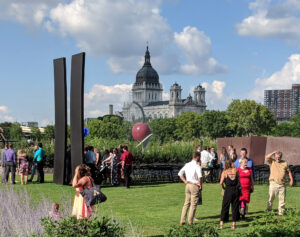
A wedding ceremony breaking up at the Minneapolis Sculpture Garden, in front of Double Curve by Ellsworth Kelly
A partnership between the Walker Art Center and the Minneapolis park system, the Sculpture Garden showcases works from the Walker’s modern and contemporary art collection in the setting of an urban park. The Garden is 100% free and open 365 days a year, from 6 a.m. to midnight. When the park opened in 1988, it was one of the first of its kind in the United States. A new and improved Sculpture garden debuted in May 2017 after a major renovation.
The Garden is home to more than 40 outdoor sculptures created by artists from 10 different countries around the world, many made specifically for the setting. Since the 2017 reconstruction, the site features ecologically sustainable water management, habitat for plants and wildlife, and creative landscape elements that showcase the artworks in nature.

September Room by Mark Manders
The Walker commissioned a number of new sculptures as part of the renovation. My favorite of these is September Room by Mark Manders. It combines human figures and architectural elements that evoke the past and present, the familiar and the unfamiliar. The delicately textured surfaces look like wood or wet clay. It’s hard to believe they are metal.
Something old in the Minneapolis Sculpture Garden
I love revisiting my favorite sculptures from the previous incarnation of the Sculpture Garden. They are like old friends.
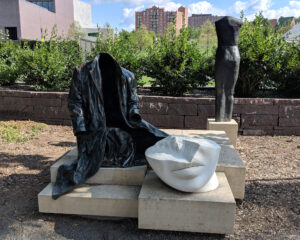
Without Words by Judith Shea
Without Words
You might guess that artist Judith Shea originally trained as a fashion designer. She first used clothes as abstract forms and later as substitutes for human presence. She eventually placed her figures into groups of objects, suggesting a story.
This trio seems to be carrying on a dialogue about modern life and antiquity. The head was based on an Egyptian 18th Dynasty sculpture of Queen Tiye. The dress is reminiscent of both of classical Greek sculpture and 1950s couture. The modern coat recalls the flowing drapery of classical sculpture.
Walking Man
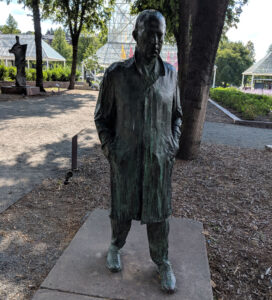
Walking Man by George Segal
George Segal’s sculptures are tributes to ordinary people in everyday situations. Segal created his sculptures from plaster casts formed directly on live models (often friends or other artists). He combined these lifelike bodies with commonplace objects to create scenes that imply a story.
I tend to think of Walking Man as “rain man.” It looks like he’s wearing a raincoat and he seems a bit glum. As I might be if I was walking along in the rain without an umbrella. Walking Man stands on a simple fragment of concrete sidewalk, rather than a traditional pedestal. He is part of a long tradition of striding figures in the history of art.
Spoonbridge and Cherry
The most famous piece in the sculpture garden, Claes Oldenburg’s Spoonbridge and Cherry has become a familiar and iconic symbol for Minneapolis. The renovation features Spoonbridge even more prominently as the centerpiece of the collection, placing it smack dab in the middle at the end of a long, tree-lined walkway. It rests in its very own pond, with the Minneapolis skyline and Basilica in the background. Along with the new blue rooster.
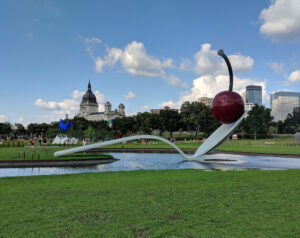
Spoonbridge and Cherry by Claes Oldenburg And Coosje Van Bruggen
More than 50 feet long, Spoonbridge and Cherry delights visitors. You can sit and gaze upon it in chairs set up nearby. More people are taking goofy pictures with the cherry than are contemplating its meaning, however.
Oldenburg was a key voice in the Pop Art movement who made monumental outdoor works with Coosje van Bruggen, his wife and artistic partner. Spoonbridge and Cherry is one of their most celebrated collaborations, commissioned the year the Garden opened in 1988.
Something new in the Minneapolis Sculpture Garden
Speaking of monumental, two huge and memorable new pieces are the giant blue rooster (which most, meaning me, persist in thinking of as the big blue chicken, even though he’s a rooster) and the Robert Indiana LOVE sculpture.
Hahn/Cock
The Walker’s notes say Katharina Fritsch’s blue rooster is “at once lifelike and completely unreal.” I cannot dispute that. Fritsch makes animals and everyday objects extraordinary through bold shifts in scale, color, and material.
The rooster towers nearly 25 feet over the Minneapolis Sculpture Garden. This gives you a better idea of the scale:
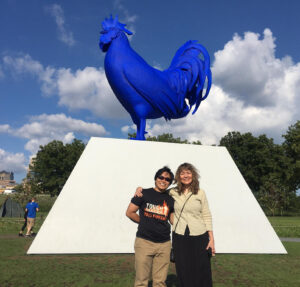
Hahn/Cock by Katharina Fritsch
The rooster can be a symbol of pride, power, and courage, or of posturing and macho prowess. Fritsch has admitted that she enjoys “games with language,” and the sculpture’s tongue-in-cheek title knowingly plays on its double meaning. It’s an unexpected take on the idea of a traditional public monument, showing how ordinary objects can become symbolic.
Speaking of symbolic, let’s move on to the Robert Indiana.

LOVE
In the late 1950s, Robert Indiana began making paintings and sculptures that featured words. Single, poetically powerful words, such as “EAT,” “DIE,” and his most famous, “LOVE.” LOVE is the artist’s most iconic image, one that has resonated across cultures and generations. You may recall seeing it on a postage stamp.
Skyline mini golf at the Minneapolis Sculpture Garden
Not free, but fun, the Walker has constructed a mini golf course on the terrace, with golf holes designed by artists, and promises “unbelievable views overlooking the Minneapolis skyline.”
If you want to play, get there early. Mini golf sells out (as I discovered, much to my chagrin). I’d suggest arriving at least an hour before closing to get on the waiting list. I arrived a half-hour before closing on a Saturday. FAIL! So sorry I can’t share pictures of the golf course or those unbelievable views at this time.
Thinking of moving to Minneapolis?
If you’re thinking of moving to Minneapolis, call Scott Haubrich at (612) 298-5400 or send an email to scott@buyrentsell.com for more information. Click here to go to the homepage.
Minneapolis neighborhoods in this post: Lowry Hill
